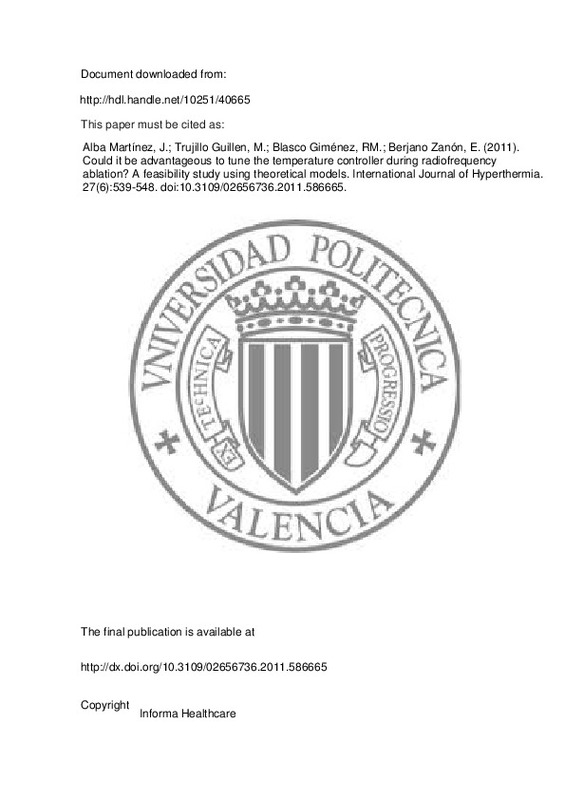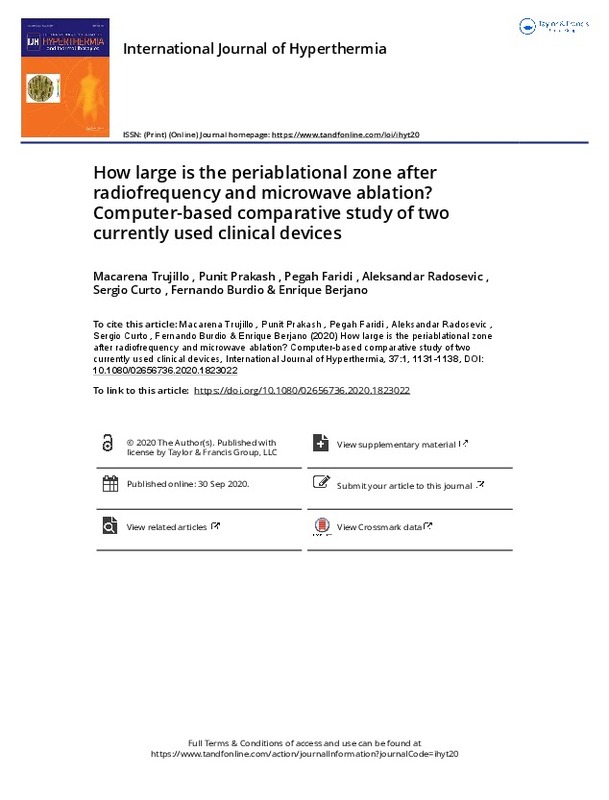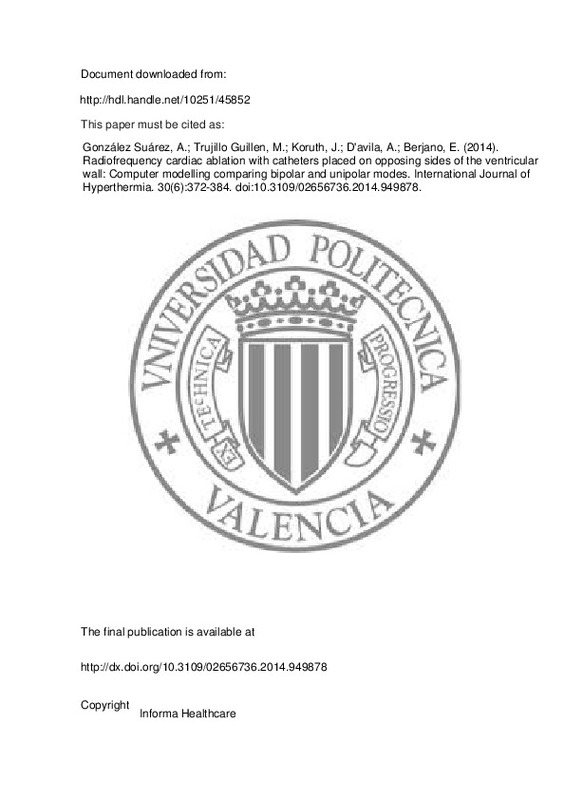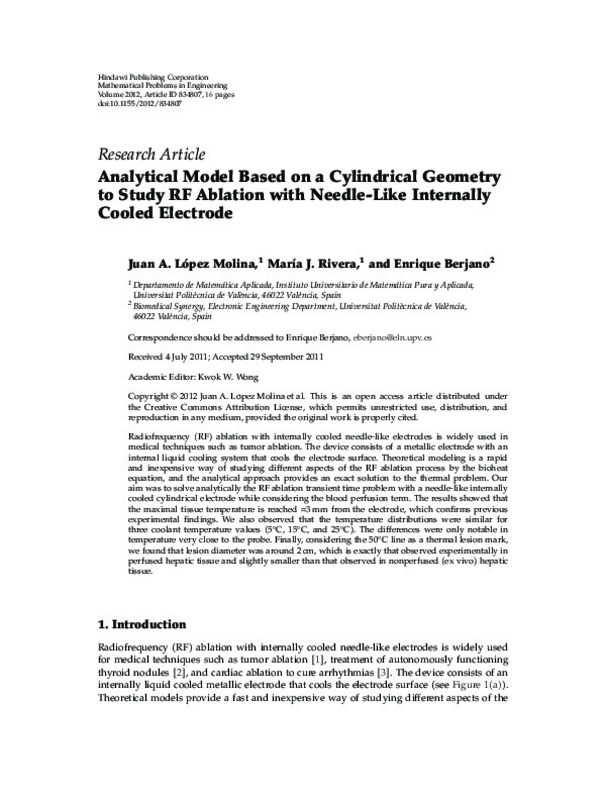JavaScript is disabled for your browser. Some features of this site may not work without it.
Buscar en RiuNet
Listar
Mi cuenta
Estadísticas
Ayuda RiuNet
Admin. UPV
Could it be advantageous to tune the temperature controller during radiofrequency ablation? A feasibility study using theoretical models
Mostrar el registro sencillo del ítem
Ficheros en el ítem
| dc.contributor.author | Alba Martínez, José
|
es_ES |
| dc.contributor.author | Trujillo Guillen, Macarena
|
es_ES |
| dc.contributor.author | Blasco Giménez, Ramón Manuel
|
es_ES |
| dc.contributor.author | Berjano Zanón, Enrique
|
es_ES |
| dc.date.accessioned | 2014-10-06T12:43:19Z | |
| dc.date.available | 2014-10-06T12:43:19Z | |
| dc.date.issued | 2011-09 | |
| dc.identifier.issn | 0265-6736 | |
| dc.identifier.uri | http://hdl.handle.net/10251/40665 | |
| dc.description.abstract | Purpose: To assess whether tailoring the Kp and Ki values of a proportional-integral (PI) controller during radiofrequency (RF) cardiac ablation could be advantageous from the point of view of the dynamic behaviour of the controller, in particular, whether control action could be speeded up and larger lesions obtained. Methods: Theoretical models were built and solved by the finite element method. RF cardiac ablations were simulated with temperature controlled at 55 degrees C. Specific PI controllers were implemented with Kp and Ki parameters adapted to cases with different tissue values (specific heat, thermal conductivity and electrical conductivity) electrode-tissue contact characteristics (insertion depth, cooling effect of circulating blood) and electrode characteristics (size, location and arrangement of the temperature sensor in the electrode). Results: The lesion dimensions and T(max) remained almost unchanged when the specific PI controller was used instead of one tuned for the standard case: T(max) varied less than 1.9 degrees C, lesion width less than 0.2 mm, and lesion depth less than 0.3 mm. As expected, we did observe a direct logical relationship between the response time of each controller and the transient value of electrode temperature. Conclusion: The results suggest that a PI controller designed for a standard case (such as that described in this study), could offer benefits under different tissue conditions, electrode-tissue contact, and electrode characteristics. | es_ES |
| dc.description.sponsorship | This work received financial support from the Spanish 'Plan Nacional de I+D+I del Ministerio de Ciencia e Innovacion' Grant no. TEC2008-01369/TEC and FEDER Project MTM2010-14909. The translation of this paper was funded by the Universitat Politecnica de Valencia, Spain. The authors alone are responsible for the content and writing of the paper | en_EN |
| dc.language | Inglés | es_ES |
| dc.publisher | Informa Healthcare | es_ES |
| dc.relation.ispartof | International Journal of Hyperthermia | es_ES |
| dc.rights | Reserva de todos los derechos | es_ES |
| dc.subject | Ablation | es_ES |
| dc.subject | Cardiac ablation | es_ES |
| dc.subject | Closed loop control | es_ES |
| dc.subject | Finite element method | es_ES |
| dc.subject | Radiofrequency ablation | es_ES |
| dc.subject | Temperature controlled ablation | es_ES |
| dc.subject | Theoretical model | es_ES |
| dc.subject.classification | INGENIERIA DE SISTEMAS Y AUTOMATICA | es_ES |
| dc.subject.classification | MATEMATICA APLICADA | es_ES |
| dc.subject.classification | TECNOLOGIA ELECTRONICA | es_ES |
| dc.title | Could it be advantageous to tune the temperature controller during radiofrequency ablation? A feasibility study using theoretical models | es_ES |
| dc.type | Artículo | es_ES |
| dc.identifier.doi | 10.3109/02656736.2011.586665 | |
| dc.relation.projectID | info:eu-repo/grantAgreement/MICINN//TEC2008-01369/ES/MODELOS COMPUTACIONALES E INVESTIGACION EXPERIMENTAL EN EL ESTUDIO DE TECNICAS QUIRURGICAS DE CALENTAMIENTO DE TEJIDOS BIOLOGICOS MEDIANTE CORRIENTES DE RADIOFRECUENCIA./ | es_ES |
| dc.relation.projectID | info:eu-repo/grantAgreement/MICINN//MTM2010-14909/ES/HIPERCICLICIDAD Y CAOS DE OPERADORES/ | es_ES |
| dc.rights.accessRights | Abierto | es_ES |
| dc.contributor.affiliation | Universitat Politècnica de València. Instituto Universitario de Automática e Informática Industrial - Institut Universitari d'Automàtica i Informàtica Industrial | es_ES |
| dc.contributor.affiliation | Universitat Politècnica de València. Instituto Universitario de Matemática Pura y Aplicada - Institut Universitari de Matemàtica Pura i Aplicada | es_ES |
| dc.contributor.affiliation | Universitat Politècnica de València. Departamento de Matemática Aplicada - Departament de Matemàtica Aplicada | es_ES |
| dc.contributor.affiliation | Universitat Politècnica de València. Departamento de Ingeniería de Sistemas y Automática - Departament d'Enginyeria de Sistemes i Automàtica | es_ES |
| dc.contributor.affiliation | Universitat Politècnica de València. Departamento de Ingeniería Electrónica - Departament d'Enginyeria Electrònica | es_ES |
| dc.description.bibliographicCitation | Alba Martínez, J.; Trujillo Guillen, M.; Blasco Giménez, RM.; Berjano Zanón, E. (2011). Could it be advantageous to tune the temperature controller during radiofrequency ablation? A feasibility study using theoretical models. International Journal of Hyperthermia. 27(6):539-548. https://doi.org/10.3109/02656736.2011.586665 | es_ES |
| dc.description.accrualMethod | S | es_ES |
| dc.relation.publisherversion | http://dx.doi.org/10.3109/02656736.2011.586665 | es_ES |
| dc.description.upvformatpinicio | 539 | es_ES |
| dc.description.upvformatpfin | 548 | es_ES |
| dc.type.version | info:eu-repo/semantics/publishedVersion | es_ES |
| dc.description.volume | 27 | es_ES |
| dc.description.issue | 6 | es_ES |
| dc.relation.senia | 210642 | |
| dc.description.references | Gaita, F., Caponi, D., Pianelli, M., Scaglione, M., Toso, E., Cesarani, F., … Leclercq, J. F. (2010). Radiofrequency Catheter Ablation of Atrial Fibrillation: A Cause of Silent Thromboembolism? Circulation, 122(17), 1667-1673. doi:10.1161/circulationaha.110.937953 | es_ES |
| dc.description.references | Anfinsen, O.-G., Aass, H., Kongsgaard, E., Foerster, A., Scott, H., & Amlie, J. P. (1999). Journal of Interventional Cardiac Electrophysiology, 3(4), 343-351. doi:10.1023/a:1009840004782 | es_ES |
| dc.description.references | PETERSEN, H. H., CHEN, X., PIETERSEN, A., SVENDSEN, J. H., & HAUNSO, S. (2000). Tissue Temperatures and Lesion Size During Irrigated Tip Catheter Radiofrequency Ablation: An In Vitro Comparison of Temperature-Controlled Irrigated Tip Ablation, Power-Controlled Irrigated Tip Ablation, and Standard Temperature-Controlled Ablation. Pacing and Clinical Electrophysiology, 23(1), 8-17. doi:10.1111/j.1540-8159.2000.tb00644.x | es_ES |
| dc.description.references | Tungjitkusolmun, S., Woo, E. J., Cao, H., Tsai, J. Z., Vorperian, V. R., & Webster, J. G. (2000). Thermal—electrical finite element modelling for radio frequency cardiac ablation: Effects of changes in myocardial properties. Medical & Biological Engineering & Computing, 38(5), 562-568. doi:10.1007/bf02345754 | es_ES |
| dc.description.references | Lai, Y.-C., Choy, Y. B., Haemmerich, D., Vorperian, V. R., & Webster, J. G. (2004). Lesion Size Estimator of Cardiac Radiofrequency Ablation at Different Common Locations With Different Tip Temperatures. IEEE Transactions on Biomedical Engineering, 51(10), 1859-1864. doi:10.1109/tbme.2004.831529 | es_ES |
| dc.description.references | Jain, M. K., & Wolf, P. D. (1999). Temperature-controlled and constant-power radio-frequency ablation: what affects lesion growth? IEEE Transactions on Biomedical Engineering, 46(12), 1405-1412. doi:10.1109/10.804568 | es_ES |
| dc.description.references | Panescu, D., Whayne, J. G., Fleischman, S. D., Mirotznik, M. S., Swanson, D. K., & Webster, J. G. (1995). Three-dimensional finite element analysis of current density and temperature distributions during radio-frequency ablation. IEEE Transactions on Biomedical Engineering, 42(9), 879-890. doi:10.1109/10.412649 | es_ES |
| dc.description.references | Hong Cao, Vorperian, V. R., Tungjitkusolmun, S., Jan-Zern Tsai, Haemmerich, D., Young Bin Choy, & Webster, J. G. (2001). Flow effect on lesion formation in RF cardiac catheter ablation. IEEE Transactions on Biomedical Engineering, 48(4), 425-433. doi:10.1109/10.915708 | es_ES |
| dc.description.references | Tungjitkusolmun, S., Vorperian, V. R., Bhavaraju, N., Cao, H., Tsai, J.-Z., & Webster, J. G. (2001). Guidelines for predicting lesion size at common endocardial locations during radio-frequency ablation. IEEE Transactions on Biomedical Engineering, 48(2), 194-201. doi:10.1109/10.909640 | es_ES |
| dc.description.references | Schutt, D., Berjano, E. J., & Haemmerich, D. (2009). Effect of electrode thermal conductivity in cardiac radiofrequency catheter ablation: A computational modeling study. International Journal of Hyperthermia, 25(2), 99-107. doi:10.1080/02656730802563051 | es_ES |
| dc.description.references | Langberg, J. J., Calkins, H., el-Atassi, R., Borganelli, M., Leon, A., Kalbfleisch, S. J., & Morady, F. (1992). Temperature monitoring during radiofrequency catheter ablation of accessory pathways. Circulation, 86(5), 1469-1474. doi:10.1161/01.cir.86.5.1469 | es_ES |
| dc.description.references | Calkins, H., Prystowsky, E., Carlson, M., Klein, L. S., Saul, J. P., & Gillette, P. (1994). Temperature monitoring during radiofrequency catheter ablation procedures using closed loop control. Atakr Multicenter Investigators Group. Circulation, 90(3), 1279-1286. doi:10.1161/01.cir.90.3.1279 | es_ES |
| dc.description.references | Lennox CD, Temperature controlled RF coagulation. Patent number: 5.122.137 Hudson NH | es_ES |
| dc.description.references | Edwards SD, Stern RA, Electrode and associated system using thermally insulated temperature sensing elements. Patent number: US Patent 5,456,682 | es_ES |
| dc.description.references | Panescu D, Fleischman SD, Whayne JG, Swanson DK, (EP Technology. Effects of temperature sensor placement on performance of temperature-controlled ablation. IEEE 17th Annual Conference, Engineering in Medicine and Biology Society, Montreal, Canada (1995) | es_ES |
| dc.description.references | BLOUIN, L. T., MARCUS, F. I., & LAMPE, L. (1991). Assessment of Effects of a Radiofrequency Energy Field and Thermistor Location in an Electrode Catheter on the Accuracy of Temperature Measurement. Pacing and Clinical Electrophysiology, 14(5), 807-813. doi:10.1111/j.1540-8159.1991.tb04111.x | es_ES |
| dc.description.references | Berjano, E. J. (2006). BioMedical Engineering OnLine, 5(1), 24. doi:10.1186/1475-925x-5-24 | es_ES |
| dc.description.references | Bhavaraju, N. C., Cao, H., Yuan, D. Y., Valvano, J. W., & Webster, J. G. (2001). Measurement of directional thermal properties of biomaterials. IEEE Transactions on Biomedical Engineering, 48(2), 261-267. doi:10.1109/10.909647 | es_ES |
| dc.description.references | Hong Cao, Tungjitkusolmun, S., Young Bin Choy, Jang-Zern Tsai, Vorperian, V. R., & Webster, J. G. (2002). Using electrical impedance to predict catheter-endocardial contact during RF cardiac ablation. IEEE Transactions on Biomedical Engineering, 49(3), 247-253. doi:10.1109/10.983459 | es_ES |
| dc.description.references | PETERSEN, H. H., & SVENDSEN, J. H. (2003). Can Lesion Size During Radiofrequency Ablation Be Predicted By the Temperature Rise to a Low Power Test Pulse in Vitro? Pacing and Clinical Electrophysiology, 26(8), 1653-1659. doi:10.1046/j.1460-9592.2003.t01-1-00248.x | es_ES |
| dc.description.references | LANGBERG, J. J., LEE, M. A., CHIN, M. C., & ROSENQVIST, M. (1990). Radiofrequency Catheter Ablation: The Effect of Electrode Size on Lesion Volume In Vivo. Pacing and Clinical Electrophysiology, 13(10), 1242-1248. doi:10.1111/j.1540-8159.1990.tb02022.x | es_ES |







![[Cerrado]](/themes/UPV/images/candado.png)




